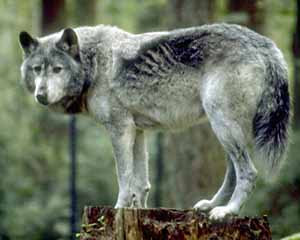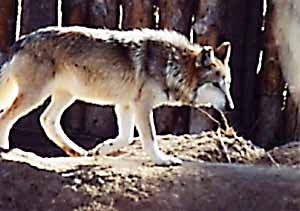Salmon wolves illegally poisoned with controversial substance
"Unfortunately, the poisoning of these two wolves is a somber
reminder of how tenuous the wolf’s foothold is in Idaho…"
-Wolf Recovery Foundation
By GREG STAHL
Express Staff Writer

photo courtesy snapshot.com
A deadly poison called Compound 1080 was used to kill two wolves near
Salmon last year, U.S. Fish and Wildlife confirmed last week.
According to Fish and Wildlife law enforcement officer Steven Magone, the
two dead wolves were found last spring—one was found in March, the other in
April—in the Meyers Cove and Panther Creek areas. They were poisoned using baited
meat.
Fish and Wildlife finally released information of the incident this
winter, Magone said, in an attempt to drum up leads in the case.
Thus far, no suspects have been named, Magone said.
Also, he added, it’s an issue of public safety.
"The poison will kill any carnivore that happens to ingest baited
meat or carcasses of dead animals that have already been poisoned, as well as cattle or
birds that have eaten poisoned meat," he said.
"Poison is not selective about the species it will affect."
Though its use is legal in Idaho under strict guidelines, the Salmon
wolves were poisoned in an illegal manner.
Gray wolves are protected by the federal Endangered Species Act. The Fish
and Wildlife Service and Defenders of Wildlife, a conservation group, are offering a
$2,500 reward for information leading to the conviction of those responsible for the
poisonings.
Compound 1080, also know as fluoroacetate, was banned from the U.S. in
1972, at which time it had been used in baited traps. The poison was re-approved in 1985
following pressure from the livestock industry for use in livestock protection collars
(LPCs).
The Idaho Legislature approved the use of Compound 1080 in Idaho last
winter, becoming the eighth state in the U.S. allowing use of the poison.
The collars, made to fit around a stock animal’s neck, have two
sealed rubber reservoirs. The reservoirs each contain 15 milliliters of a one-percent
solution of Compound 1080 and are designed to rupture when bitten by a coyote or other
predator. Ingestion of the compound is unfailingly deadly. It has no antidote.
"It’s 100-percent fatal every time," Idaho department of
Fish and Game conservation officer Lee Frost said in an interview last winter.
According to an Idaho Department of Agriculture study, "there is no
question the uncontrolled use of Compound 1080 can result in unacceptable risks to the
environment and human beings."
The two dead wolves were wearing radio telemetry collars and were
investigated because their signals weren’t moving, according to a February wolf
update provided by the Boise-based Wolf Recovery Foundation.
"Unfortunately, the poisoning of these two wolves is a somber
reminder of how tenuous the wolf’s foothold is in Idaho and how shortsighted
attitudes of a few could prolong the burdens to many rural Idahoans by delaying the
recovery of wolves in the northern Rockies," the foundation’s update states.
Wolves have gradually been creeping into the Salmon River valley this
winter near Salmon, following deer and elk descending from the Frank Church River Of No
Return Wilderness Area’s mountains. The two dead wolves are believed to be members of
the Twin Peaks pack, which calls the wilderness area home.
This summer and fall, however, the Twin Peaks pack has been exploring new
country outside the eastern border of their territory.
The pack migrated to an area that includes Bureau of Land Management land
and scattered private ranches.
The pack killed one new born cow and hunted a rancher’s horses,
according to the wolf update.
Because the pack had attacked livestock on multiple occasions, and posed
continued threats to livestock, and opportunities for relocation were limited by winter
conditions, the U.S. Fish and Wildlife Service authorized killing three of the wolves
wintering in the area.
Wildlife Services, a division of the U.S. Department of agriculture,
performed the killings.

photo courtesy snapshot.com
Where wolves roam
Reports of wolf activity are surfacing all around the mountains of Idaho,
including the Boise foothills and other semi-populated areas.
The Idaho Wolf Recovery Foundation also continues to monitor wolf
populations and behavior using radio telemetry tracking.
As winter continues to settle in, the wolves are following deer and elk
herds into the valleys which helps to explain the recent sightings.
Of 13 potential breeding pairs in Idaho, 10 were confirmed in 1999, the
foundation reported this month.
As of Jan. 1, Idaho had an estimated 154 wolves and 11 packs, according to
the foundation. Recent sightings indicate that wolves are wintering in the Stanley Basin,
Copper Basin and East Fork of the Salmon River areas locally.
Wild gray wolves were reintroduced to Idaho in 1995 and 1996 by the U.S.
Fish and Wildlife Service under the Endangered Species Act (ESA). Wolves were also
reintroduced in Yellowstone National Park and western Montana at those times.
Wolf "delisting," removal from the ESA, will not occur until all
three populations maintain at least 10 breeding pairs each for three consecutive years.
That is where the Idaho and Yellowstone populations are, according to U.S. Fish and
Wildlife Service, the federal agency responsible for wolf oversight and reintroduction.
However, the Idaho Department of Fish and Game representative on wolf
issues, John Rachael, said Fish and Wildlife has indicated that it may move to a 30
breeding pair total among all three reintroduction sites as its delisting criteria.
In 1995 and 1996, 35 gray wolves were set free in Idaho. By the end of
1998, their numbers climbed to about 115.
Currently Idaho wolves are under federal control, but jurisdiction will be
transferred to the state when they are taken off the ESA. It is unclear whether the Idaho
Legislature will allow Fish and Game to oversee management of the species when delisting
occurs.
Also, before delisting transpires, Idaho must have a wolf management plan
ready to implement that insures the continued survival of wolves above the minimum species
survival levels set by the federal government.
Such a plan was drafted by the Idaho Wolf Oversight Committee last year.
It needs the legislature’s and U.S. Fish and Wildlife’s approval before
implementation would be allowed, Rachael said in an interview.
Rachael said that, at this point, the legislature is better equipped to
deal with wolf management. The issue is one of more social and political significance than
biological, he said.
Many say proper management belongs with Fish and Game, the caretaker for
all other state species.
"The reality is that the biology of wolves is far from being the most
difficult portion of the planning process," Rachael said.
He conceded, however, that the legislative oversight committee is not
striving to achieve maximum potential wolf populations in Idaho.
"It would probably be a fair statement to say the oversight committee
would like to see wolves managed at a minimum level," he said. "The
committee’s intention is to get enough wolves to get them off the [endangered] list
and keep them off the list, but to minimize the conflicts with other human uses" such
as recreation and ranching.
The Legislature "is definitely, at least in the foreseeable future,
going to play a role in guiding or overseeing state involvement," Rachael said.
Fish and Game is "absolutely not" suited to management of a
controversial species like wolves, he added.

